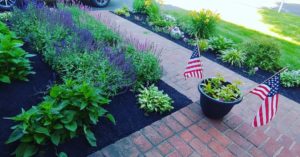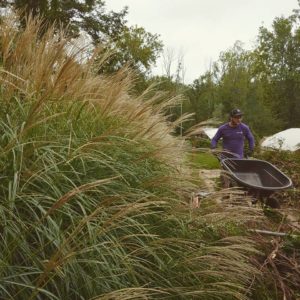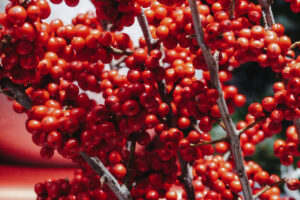How to Water Wisely During the Summer
It’s July, and it’s another hot one!
July is also Smart Irrigation Month that reminds us that we need to water our lawns and landscapes wisely for optimal health and vitality.
8 Tips for Watering Your Lawn during the Summer
Southeastern PA lawns have cool season grasses, which means that turfgrass grows best in cooler temperatures. And Pennsylvania summers aren’t known to be cool ones.
So, your lawn may look brown and dry. And yet, your turfgrass is still alive—it’s just in dormancy. When it rains again, the turf will green up.
However, you can keep your Bucks County grass greener longer during a heatwave when you take care of it in the spring and early Summer.
Here are eight tips to keep your lawn looking green even during a period of drought:
- Make sure to fertilize your lawn with the appropriate nutrition based on your soil and turf needs – Your soil needs fertilizer to keep the nutrients and moisture in the ground over the Summer.
- Put down weed control to prevent grassy weeds from taking over during a stretch of hot, dry days – Many grassy weeds, such as crabgrass, are warm season grasses that grow well in hot, dry conditions.
- Mow high by only taking the top third off the grass plant – You encourage turfgrass to grow deep roots and thick stands of grass that survive heat stress better than a scalped lawn.
- Only water once or twice per week during the Summer – Your lawn only needs infrequent, deep soakings to stay alive. Use a lawn watering system, such as in-ground irrigation, to provide those weekly deep soakings.
- Water your lawn in the early morning hours, between 4 a.m. to 6 a.m., when temperatures are cool and there’s little wind. It’s the best time to water the lawn in hot weather.
- Invest in an in-ground sprinkler system or retrofit your old sprinkler system – Today’s lawn sprinkler systems come equipped with weather and moisture sensors, timers, and Bluetooth technology.
- Use soaker hoses with a timer if you don’t want to invest in an irrigation system – It’s impossible to water your lawn well with a garden hose unless you only have a strip of turf for your yard. Instead, your lawn needs continual water for one to two hours, once or twice a week, to get the deep irrigation it needs. Soaker hoses are the best way to water your lawn without a sprinkler system because they slowly emit water into the soil rather than just sprinkling the surface.
- Make sure you fix any yard drainage problems – While drainage isn’t an issue during a heatwave, it becomes a problem when heavy thunderstorms roll through and dump a lot of water in a short time.
If you have questions about your lawn’s health and watering needs, feel free to reach out to us at Jamison Lawn Care. We’re always happy to help you have the best property in southeastern PA.
Learn more: Pruning Your Spring Shrubs + Bee Balm
Sources:
LoveYourLandscape.org, Harnessing H2O: Making Every Drop Count.
Ibid, Weathering the Drought: How to Manage Your Yard Sustainably.
Plant of the Month: Hydrangeas
What type of hydrangea is your favorite—mop head or lace cap?
Today’s hydrangeas are versatile and come in many different types compared to what grew in your grandparents’ yard 50 years ago.
Indeed, you find hydrangeas in these colors:
- Bright blue
- Crimson
- Lime green
- Variegated colors
- White.
Here’s the lowdown on hydrangeas:
- Their botanical name is Hydrangea spp.
- Common names for hydrangea are hydrangea and Hortensia
- Hydrangeas are shrubs that can grow up to 15’
- Hydrangeas grow well in full sun to partial shade
- Hydrangeas grow in many different types of soils but prefer well-drained ones
- Hydrangeas can grow at any pH level
- Hydrangeas bloom from mid-summer through fall
- Hydrangeas are native to Asia and the Americas
- The entire plant is toxic to animals and people
- The blooms make a lovely cut flower and can be dried.
Read more: Why Your Garden Beds and Landscape Need Mulch + Plant of the Month
5 Types of Hydrangeas That Grow Well in Southeastern PA
Since Buckingham and Warwick Townships are in growing zones 6b-7a, here are five types of hydrangeas you might want to plant in your Bucks County landscape:
- Climbing hydrangea
- French hydrangea
- Oakleaf hydrangea
- Panicle hydrangea
- Smooth hydrangea.
Changing the Colors of Your Hydrangeas
Did you know that you can change the color of lace cap and mop head hydrangeas? It’s all in the soil. Hydrangeas love aluminum, so when you change how much aluminum your hydrangea can uptake from the ground, you change your hydrangeas’ colors.
For example, you’ll use something that makes the soil acidic or alkaline to determine how much aluminum goes into the shrub.
When you add acidic products, such as used coffee grounds, the blossoms change to blue and lavender-blue.
Likewise, you can add lime to the soil to change the hydrangea blooms to red or pink. If you have white mop heads and lace cap hydrangeas, they’ll stay white no matter what you do to the soil.
If you want us at Jamison Lawn Care to plant hydrangea shrubs in your Doylestown or Hatboro landscape or provide lawn care services, call us today at (267)621-4747 or fill out our contact form.
Sources:
HGTV.com, How to Change Hydrangea Color.
TheSpruce.com, 14 Beautiful Hydrangea Varieties.
Ibid, How to Grow Hydrangeas.
Jamison Lawn Care serves homeowners and commercial properties in Buckingham and Warwick Townships, including these Pennsylvania towns: Chalfont, Doylestown, Furlong, Hatboro, Horsham, Jamison, Southampton, Warminster, Warrington, and Warwick.
|
|
Jamison Lawn Care | 267-621-4747
P.O. Box 32, PA 18929
www.jamisonlawncare.com
|
|

|
|





